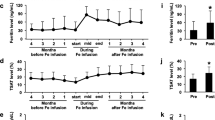Abstract
Idiopathic nephrotic syndrome (INS) is characterized by marked urinary excretion of albumin and other intermediate-sized plasma proteins, such as transferrin and vitamin D-binding protein. Some cases even develop anemia. The aim of this study was to investigate the changes in serum iron, transferrin, and erythropoietin, and the relationships between serum and urine transferrin and erythropoietin. Thirty-seven children with INS and 35 age-and sex-matched healthy children were investigated. The indexes related to iron metabolism, including serum iron, ferritin, transferrin, total iron-binding capacity (TIBC), transferrin saturation, and hematological parameters [hemoglobin (Hb), mean corpuscular volume (MCV), mean corpuscular hemoglobin (MCH)], and urinary transferrin and erythropoietin were measured in 37 children with INS before treatment and at the remission stage. Thirty-five age-and sex-matched healthy children served as controls. Serum iron levels (18.8 ± 3.8) μmol/L in INS patients before treatment were significantly lower than those of the healthy controls (22.2 ± 3.8) μmol/L and those measured at the remission stage (21.0 ± 3.5) μmol/L (all P < 001). Serum transferrin levels in INS patients before therapy (1.9 ± 0.3) g/L also decreased compared with the healthy controls (3.1 ± 0.5) g/L and the measures at the remission stage (2.9 ± 0.6) g/L (all P < 0.01). In contrast, serum TIBC and transferrin saturation were significantly higher in INS patients before treatment than in the healthy controls [TIBC (56.4 ± 9.2) μmol/L vs (50.7 ± 6.8) μmol/L, P < 0.01; transferrin saturation (55.7 ± 9.2)% vs (46.4 ± 8.2)%, P < 0.01] and they were also higher than the measures at remission stage [(51.9 ± 7.7) μmol/L and (47.4 ± 13.3) μmol/L] (all P < 0.01). Serum transferrin was positively correlated with serum albumin (r = 0.609, P < 0.01) and negatively correlated with urinary transferrin (r = −0.550, P < 0.01) in INS patients before treatment. We conclude that serum iron, transferrin and erythropoietin levels are markedly decreased in INS patients, which may be partially related to the urinary loss of these indexes.
Similar content being viewed by others
References
Grymonprez A, Proesmans W, Van Dyck M, Jans I, Goos G, Bouillon R. Vitamin D metabolites in childhood nephrotic syndrome. Pediatr Nephrol, 1995, 9(3): 278–281
Deegens J K, Wetzels J F. Fractional excretion of high-and low-molecular weight proteins and outcome in primary focal segmental glomerulosclerosis. Clin Nephrol, 2007, 68(4): 201–208
Varghese S A, Powell T B, Budisavljevic M N, Oates J C, Raymond J R, Almeida J S, Arthur J M. Urine biomarkers predict the cause of glomerular disease. J Am Soc Nephrol, 2007, 18(3): 913–922
Cooper M A, Biddington B, Miller N L, Alfrey A C. Urinary iron specification in nephrotic syndrome. Am J Kidney Dis, 1995, 25(2): 314–319
Beard J L, Murray-Kolb L E, Rosales F J, Solomons N W, Angelilli M L. Interpretation of serum ferritin concentrations as indicators of total-body iron stores in survey populations: the role of biomarkers for the acute phase response. Am J Clin Nutr, 2006, 84(6): 1498–1505
Sun X, Kaysen G A. Albumin and transferrin synthesis are increased in H4 cells by serum from analbuminemic or nephrotic rats. Kidney Int, 1994, 45(5): 1381–1387
Prinsen B H, de Sain-van der Velden M G, Kaysen G A, Straver H W, van Rijn H J, Stellaard F, Berger R, Rabelink T J. Transferrin synthesis is increased in nephrotic patients insufficiently to replace urinary losses. J Am Soc Nephrol, 2001, 12(5): 1017–1025
Branten A J, Swinkels D W, Klasen I S, Wetzels J F. Serum ferritin levels are increased in patients with glomerular diseases and proteinuria. Nephrol Dial Transplant, 2004, 19(11): 2754–2760
Kemper M J, Bello A B, Altrogge H, Timmermann K, Ludwig K, Müller-Wiefel D E. Iron homeostasis in relapsing steroid-sensitive nephrotic syndrome of childhood. Clin Nephrol, 1999, 52(1): 25–29
Castellino P, Cataliotti A. Changes of protein kinetics in nephrotic patients. Curr Opin Clin Nutr Metab Care, 2002, 5(1): 51–54
Shibasaki T, Misawa T, Matsumoto H, Abe S, Nakano H, Matsuda H, Gomi H, Ohno I, Ishimoto F, Sakai O. Characteristics of anemia in patients with nephrotic syndrome. Nippon Jinzo Gakkai Shi, 1994, 36(8): 896–901
Cooper M A, Buddington B, Miller N L, Alfrey A C. Urinary iron specification in nephrotic syndrome. Am J Dis, 1995, 25(2): 314–319
Howard R L, Buddington B, Alfrey A C. Urinary albumin, transferrin, and iron excretion in diabetic patients. Kidney Int, 1991, 40(5): 923–926
Feinstein S, Becker-Cohen R, Algur N, Raveh D, Shalev H, Shvil Y, Frishberg Y. Erythropoietin deficiency causes anemia in nephrotic children with normal kidney function. Am J Kidney Dis, 2001, 37(4):736–742
Alfrey A C. Role of iron and oxygen radicals in the progression of chronic renal failure. Am J Kidney Dis, 1994, 23(2): 183–187
Nankivell B J, Boadle R A, Harris D C. Iron accumulation in human chronic renal disease. Am J Kidney Dis, 1992, 20(6): 580–584
kaysen G A, Sun X, Jones H Jr, Martin V I, Joles J A, Tsukamoyo H, Couser W G, Bander H. Non-iron-mediated alteration in hepatic transferrin gene expression in the nephrotic rat. Kidney Int, 1995, 47(4): 1068–1077
Mähr N, Neyer U, Prischl F, Kramar R, Mayer G, Kronenberg F, Lhotta K. Proteinuria and hemoglobin levels in patients with primary glomerular disease. Am J Kidney Dis, 2005, 46(3): 424–431
Terrier B, Fakhouri F, Sultanik P, Delarue R, Hummel A. Urinary erythropoietin excretion: an unknown cause of anemia during nephrotic syndrome. Rev Med Interne, 2006, 27(8): 643–645
Vaziri N D, Kaupke C J, Barton C H, Gonzales E. Plasma concentration and urinary excretion of erythropoietin in adult nephrotic syndrome. Am J Med, 1992, 92(1): 35–40
Zhou X J, Vaziri N D. Erythropoietin metabolism and pharmacokinetics in experimental nephrosis. Am J Physiol Renal Physiol, 1992, 263(5pt2): F812–F815
Author information
Authors and Affiliations
Corresponding author
Rights and permissions
About this article
Cite this article
Lu, H., Wang, L., Fan, Q. et al. Serum erythropoietin and transferrin in children with idiopathic nephrotic syndrome. Front. Med. China 2, 286–289 (2008). https://doi.org/10.1007/s11684-008-0054-6
Received:
Accepted:
Published:
Issue Date:
DOI: https://doi.org/10.1007/s11684-008-0054-6




